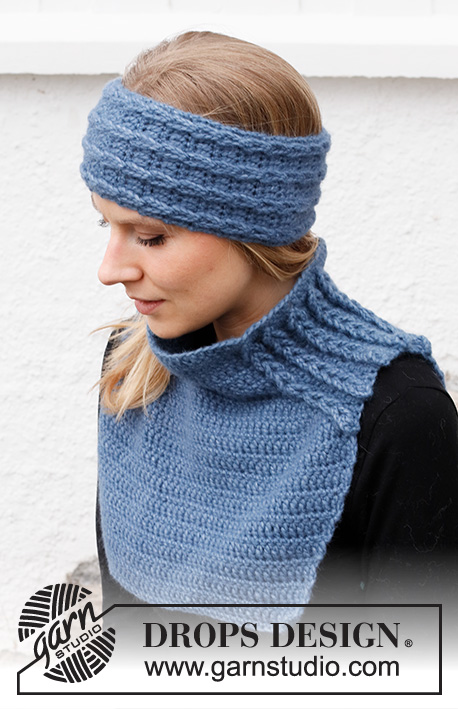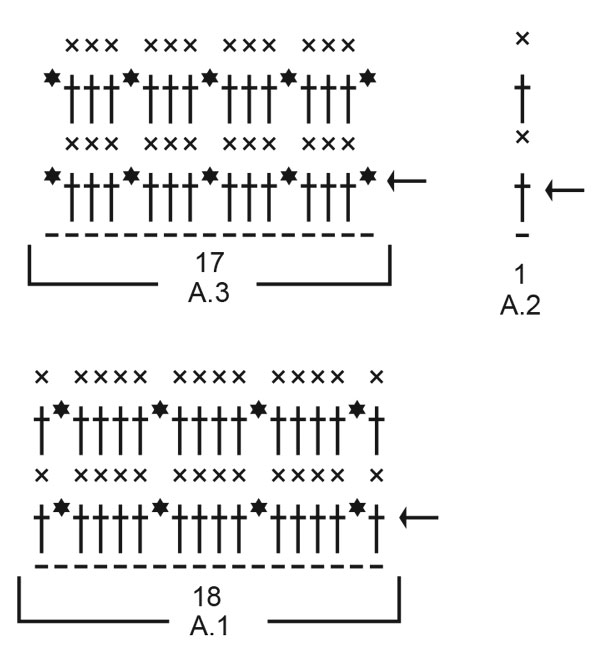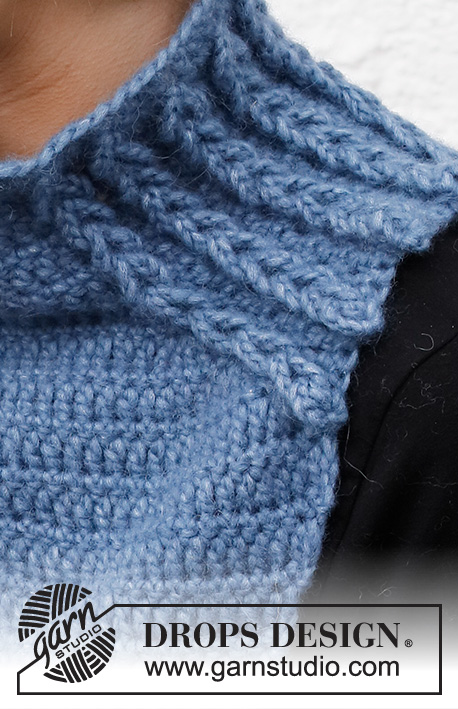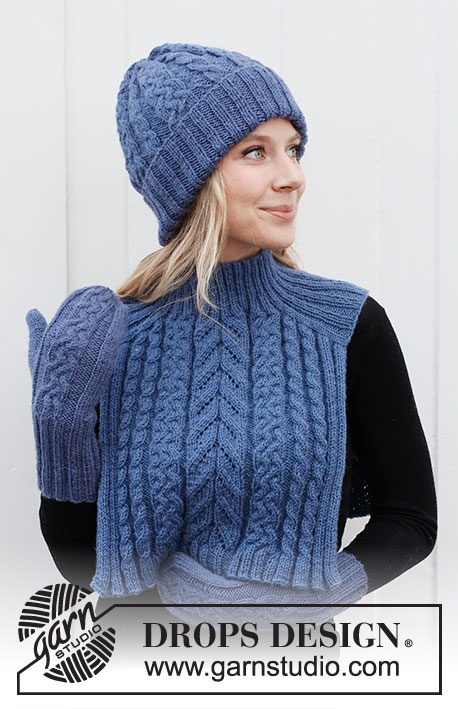Comments / Questions (4)
![]() Lyse Goyette wrote:
Lyse Goyette wrote:
Bonjour pour faire le bandeau , ils disent de crocheter A1 , c'est tout comment on fait pour les torsades dois je crocheter A 2 ou A 3 ... Merci j'attends votre réponse je suis du Québec Canada .
17.02.2022 - 22:55DROPS Design answered:
Bonjour Mme Goyette, ces torsades sont composées de ronds de mailles en l'air que vous crochèterez ensemble pour former ces torsades à la fin (cf explications écrites); cette vidéo montre (pour un autre modèle) comment réaliser ces ronds de mailles en l'air (étoile noire dans ces diagrammes) et comment les crocheter ensemble pour former les torsades. Bon crochet!
18.02.2022 - 08:21
![]() Eva wrote:
Eva wrote:
Hej! Det står läs VIRKINFORMATION på pannbandets beskrivning. Avsluta varvet med smygmaska i tredje luftmaskan. Men där finns ju ingen tredje luftmaska då dessa endast virkas i början på stolpvarvet. Vad menas och hur ska man gör? Mvh Eva (I början av varje varv med stolpar virkas det 3 luftmaskor, dessa luftmaskorna ersätter inte första stolpen, utan virkas i tillägg till maskorna på varvet. Varvet avslutas med 1 smygmaska i 3:e luftmaskan i början av varvet.)
27.10.2021 - 20:48DROPS Design answered:
Hei Eva. Pannebåndet hekles frem og tilbake (rader) og under hekleinformasjon står det at du skal hekle 3 luftmaske på begynnelsen av hver rad/omgang med staver, disse luftmaskene erstatter ikke første stav, men hekles i tillegg til maskene på omgangen/raden. Denne informasjonen gjelder både pannebåndet (hekles frem og tilbake = rader) og halsen (hekles rundt = omganger). Når det så står "Omgangen avsluttes med 1 kjedemaske i 3.luftmaske på begynnelsen av omgangen", gjelder dette bare hals (altså det som hekles rundt / omgang og ikke det som hekles frem og tilbake (rader)). mvh DROPS Design
01.11.2021 - 11:04
![]() Ana wrote:
Ana wrote:
¿Qué significa grupo de lanas C o A+A? Que se puede usar un grosor C o juntar dos cabos de grosor A? Muchas gracias!
20.11.2020 - 18:38DROPS Design answered:
Hola Ana! Puedes usar un cabo de grosor C o dos cabos se grosor A (junos). El grosor obtenido sera lo mismo en dos casos. Buen trabajo!
20.11.2020 - 18:49
![]() Valentina Caiolo wrote:
Valentina Caiolo wrote:
Come posso fare diventare la fascia un cappello?
13.11.2020 - 10:30DROPS Design answered:
Buonasera Valentina, per un aiuto così personalizzato si può rivolgere al suo rivenditore DROPS di fiducia. Buon lavoro!
17.11.2020 - 22:27
Endless Links#endlesslinksset |
||||||||||||||||
 |
 |
|||||||||||||||
Crocheted head band and neck warmer in DROPS Air. Piece is crocheted with loop – cables and increase for saddle shoulders.
DROPS 214-28 |
||||||||||||||||
|
------------------------------------------------------- EXPLANATION FOR THE PATTERN: ------------------------------------------------------- PATTERN: Head band: See diagram A.1 Neck warmer: See diagrams A.2 and A.3. CROCHET TIP FOR CHAIN STITCH: If you work at the end of crochet hook the chain stitch will often be too tight. 1 chain stitch should be just as long as 1 single crochet/double crochet/treble crochet is wide. CROCHET INFORMATION: At beginning of every row/round with double crochets work 3 chain stitches, these chain stitches do not replace first double round but are worked in addition to stitches on round/row. Finish round with 1 slip stitch in 3rd chain stitch at beginning of round. At beginning of every row/round with single crochets work 1 chain stitch, this chain stitch does not replace 1st single crochet but are worked in addition to stitches on round/row. Finish round with 1 slip stitch in first single crochet on round CROCHET TIP (applies when working in the round): To make the texture the same when working back and forth, turn the piece for every round worked. I.e. work every other round from right side and wrong side as follows: Work first round from right side of piece. Finish round with 1 slip stitch in 3rd chain stitch from beginning of round. Turn piece and work next round from wrong side of piece. Finish round with 1 slip stitch in 1st single crochet at beginning of round. Turn piece and work next round from right side of piece. Work back and forth like this, with alternately one round from right side and one round from wrong side. INCREASE TIP: Increase 4 stitches on each side of shoulder stitches (A.3) in each side of piece by working 5 double crochets in a stitch (= 16 stitches increased in total on every round with increase). Increases are in each side of front and back piece, i.e. number of stitch on shoulders is always the same. Work the new stitches in pattern A.2. DECREASE TIP: Decrease 1 stitch inside 1 stitch in each side as follows: * Insert hook in next stitch, get yarn *, work from *-* 2 times in total, make 1 yarn over and pull yarn through all 3 loops on hook (= 1 stitch decreased). ------------------------------------------------------- START THE PIECE HERE: ------------------------------------------------------- HEAD BAND - SHORT OVERVIEW OF THE PIECE: Head band is worked back and forth and sewn together when finished. HEAD BAND: Work 18 chain stitches -read CROCHET TIP FOR CHAIN STITCH, on hook size 4.5 mm = US 7 with Air. Work pattern A.1 back and forth - read CROCHET INFO. REMEMBER THE CROCHET GAUGE! When diagram has been worked vertically, repeat the last 2 rows until piece measures 48 cm = 19" - or to desired length (adjust so that next row is worked from wrong side). Now work chain stitch loops vertically together into loop - cables as follows: Insert hook in first chain stitch loop from right side, pull 2nd chain stitch loop through first chain stitch loop, insert hook in 2nd chain stitch loop and pull 3rd chain stitch loop through chain stitch loop. Continue like this until all chain stitch loops have been crocheted together. Work last row back from wrong side as follows: Work 1 single crochet in every stitch and work 1 single crochet in each of the last chain stitch loops to that they don’t unravel. Cut the yarn but keep some yarn for assembly. Sew together head band mid back in one and one stitch upwards. ------------------------------------------------------- NECK WARMER - SHORT SUMMARY OF PIECE: Work piece in the round from the neck and down to increase until shoulder is finished. Work in the round, at the same time turn piece for every round - read CROCHET TIP. When increase for shoulder is done, divide piece for front and back piece and work pieces back and forth separately. NECK WARMER: Work 68-68 chain stitches - read CROCHET TIP FOR CHAIN STITCH, on hook size 5 mm = US H/8 with Air and form a ring with 1 slip stitch in first chain stitch made. Insert a marker at beginning of round = approx. mid back. Now work pattern - read CROCHET INFO AND CROCHET TIP, as follows: Work A.2 over the first 8-8 stitches (= half back piece), A.3 over the next 17-17 stitches (= shoulder stitches), A.2 over the next 17-17 stitches (= front piece), A.3 over the next 17-17 stitches (= shoulder stitches), A.2 over the last 9-9 stitches (= half back piece). When diagram has been worked vertically, repeat the last 2 rounds. Continue like this until piece measures 8-8 cm = 3⅛"-3⅛", adjust so that next round will be worked from right side. REMEMBER THE CROCHET GAUGE! Insert a marker in the middle of the 17-17 stitches on front piece. NOW MEASURE PIECE FROM HERE! Now continue pattern the same way as before, but on next round from right side increase 4 stitch on each side of shoulder stitch - read INCREASE TIP. Increase like this on every round from right side (i.e. every round with double crochets) 4-5 times in total = 132-148 stitches. After last increase work chain stitch loops in A.2 vertically together to loop cables on every shoulder as follows: Insert hook in first chain stitch loop at the top towards the neck from right side, pull 2nd chain stitch loop through first chain stitch loop, insert hook in 2nd chain stitch loop and pull 3rd chain stitch loop through chain stitch loop. Continue like this until all chain stitch loops have been crocheted together. Then work last row with single crochet from wrong side as follows: Work 1 single crochet in each of the 25-29 stitches until A.3 (= half back piece), work 1 single crochet in every stitch and work 1 single crochet around the last chain stitch loop in each of the vertical lines with chain stitch loop worked together in A.3 (= shoulder), work 1 single crochet in every stitch over the next 49-57 stitches (= front piece), work 1 single crochet in every stitch and work 1 single crochet around the last chain stitch loop in each of the vertical lines with chain stitch loops worked together in A.3 (= shoulder), work 1 single crochet in each of the remaining 24-28 stitches. Now the chain stitch loops should be fastened to not unravel. Cut the yarn. Now work front and back piece back and forth separately. FRONT PIECE: = 49-57 stitches. Begin from right side and work A.2 back and forth as before – read CROCHET INFO. On next row from wrong side decrease 1 stitch in each side of piece - read DECREASE TIP. Decrease like this every row from wrong side 4-5 times in total = 41-47 stitches. Continue until piece measures 22-24 cm = 8¾"-9½" from marker, adjust to finish after a row with single crochets from wrong side. Cut and fasten the yarn. Neck warmer measures 30-32 cm = 11¾"-12½" from neck edge and down. BACK PIECE: = 49-57 stitches. Work the same way as on front piece. |
||||||||||||||||
Diagram explanations |
||||||||||||||||
|
||||||||||||||||

|
||||||||||||||||
Have you finished this pattern?Tag your pictures with #dropspattern #endlesslinksset or submit them to the #dropsfan gallery. Do you need help with this pattern?You'll find 11 tutorial videos, a Comments/Questions area and more by visiting the pattern on garnstudio.com. © 1982-2025 DROPS Design A/S. We reserve all rights. This document, including all its sub-sections, has copyrights. Read more about what you can do with our patterns at the bottom of each pattern on our site. |
||||||||||||||||




















































Post a comment to pattern DROPS 214-28
We would love to hear what you have to say about this pattern!
If you want to leave a question, please make sure you select the correct category in the form below, to speed up the answering process. Required fields are marked *.